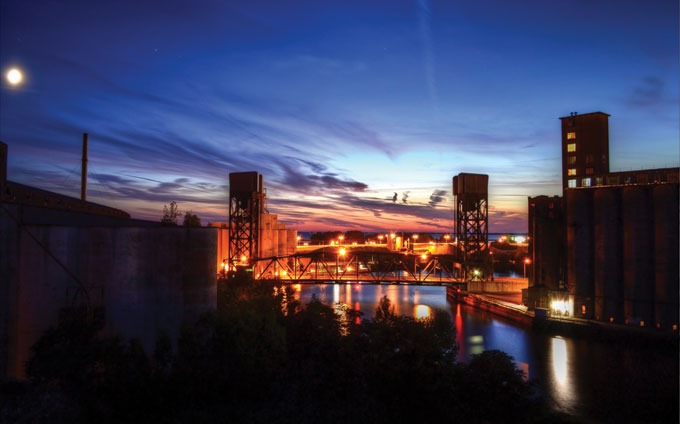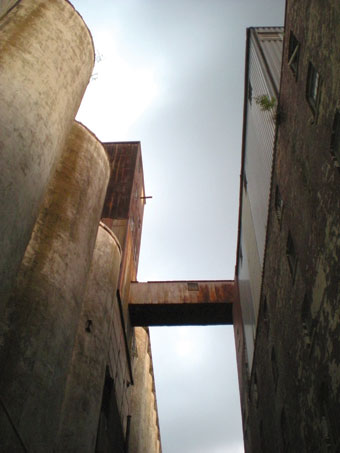City of Night
by Cory Perla

Silo City on the Buffalo River continues to emerge as a site for interesting artistic collaborations
Tall, decaying concrete structures tower over the waterfront in the Old First Ward. This is where a handful of Buffalo’s grain elevators rise from the water, including the iconic Marine A, which stands over 100 feet high.
It’s pouring rain as I drive up to this building that I’ve passed by hundreds of times but have never actually been inside of. When I pull up, there is a group of local artists waiting for me. The group includes dancers, a singer, and a photographer. We step foot inside of Marine A and I get my first glimpse of the lengthy corridor that seems to elongate, like a vertigo effect on film, as I focus on a ladder at the end of the hall that might be about half a football field away. Water is pouring onto the ladder through a hole in the structure and the sight of this urban waterfall mesmerizes everyone there, some of the group start to run toward it. As we move further into the silo my ears have to adjust to the massive echoing sound of all of our voices bouncing off of the concrete walls, walls that are nearly as tall as they are long.
“Which silo are you singing in, Scott?” asks dancer Bonnie Taylor of singer Scott Slocum, as we stand, peering up into a small hole in the top of the first silo. Slocum is part of a group of a dozen or so individuals called Silophone, who will be performing a unique vocal concert here on Saturday, September 8, as part of an event called City of Night.
“I’m not sure, one of these,” Slocum replies. “You can play with singing harmonies in a space like this. Would you like to hear a demonstration?”

Slocum, Taylor, and one of Taylor’s dancing partners, Nancy Hughes, form a circle and each begin droning a different note out from their throats for as long as they can hold their breaths. The sound is tremendous. The notes ricochet in all directions, and although the three artists are standing right in front of me, their voices seem to be coming down from the ceiling, and up from the ground. I can’t imagine what this would sound like with 10 or more singers doing this at once.
Slocum’s group is only one of many different performance groups and art instillations that will be on display at City of Night. When I showed up to Marine A, I wasn’t expecting to meet Slocum or Taylor and Hughes, who are part of a dance group called the Buffalo Contact Improvisation Jam Performance Group, or BCIJPG, for very short. I was actually there to meet photographer Christina Laing, who is as close to an expert on shooting urban decay as they come. Laing, a native Buffalonian, has traveled around to Rust Belt cities shooting images of decomposing buildings for the last three years. For this show, she has curated a photography exhibit of shots of Buffalo’s various grain elevators by herself and fellow local photographers.
“I tried to keep it all about the concept of exploring,” the 24 year-old artist told me as we sat outside of Marine A. The rain outside had stopped, but we could still hear sheets of water pouring through the building. “A lot of the people I chose have photos in the show that are of us going through these places, self portraits and group shots. I wanted to keep the whole show based around exploring because it is something that we all do together.”
Beginning in the late 19th century, Buffalo’s grain elevators, the first in the world, were used to store massive amounts of grain before it was transported to other cities throughout the country. The workers there were called “scoopers” and they worked on the yard 10 hours a day, seven days a week. These massive, iconic structures still sit on the waterfront, but most are abandoned, no longer serving the purpose for which they were designed. These huge decaying structures still attract the artists around here, though. It’s partly due to their important history. The silos are a place where people—for some of us, our ancestors—went to perform physical labor in order to support their families with whatever pay they could take away in a week.
For artists like Laing, the history of the silos is a big part of the attraction, but the decaying beauty is equally as appealing. In this case Laing was ensured that the area was safe to explore and she was given permission to wander around Silo City taking shots, but when she travels to different cities, that is not always the situation.
“It’s definitely nice when you’re allowed to be somewhere but then at the same time it’s a lot more fun when you don’t have permission,” she said.
For this show, historian and artist Dana Saylor, of Emerging Leaders in the Arts Buffalo, got permission to hold City of Night from property owner Rick Smith and site manager “Swannie” Jim Watkins. “Rick and Jim have made this space very accessible,” Saylor told me.
Two weeks ago Buffalo historian and entrepreneur Mark Goldman helped organize another “multi-dimensional arts festival” called American Grain: Revisited. The show sold out, and even then, people showed up just to stand outside and take in the atmosphere. “I was inspired by the majesty and the classic nobility of these iconic spaces and by their potential as a backdrop for the most contemporary expression in the arts,” Goldman told me in an email after the show.
Saylor and company hope to utilize the space in a similar way. She told me that Smith and Watkins want to see the structures used more often, yet kept preserved. “They’re being smart about it,” Saylor said. “They’re welcoming people to the space and showing them what is possible here.”
For Silo City the possibilities seem endless; as a performance art space, a concert ground, a place to make art, and a market to sell it, too. Those are all aspects that Saylor and her group are trying to roll into City of Night. As we stood in one of the reverberating silo rooms she summed up the event: “It’s a celebration of the art, history, and culture of Buffalo,” she said. “I want people to walk away with the feeling that good things are happening here, and they can be a part of it.”
blog comments powered by Disqus|
Issue Navigation> Issue Index > v11n36 (Week of Thursday, September 6) > City of Night This Week's Issue • Artvoice Daily • Artvoice TV • Events Calendar • Classifieds |









 Current Issue
Current Issue